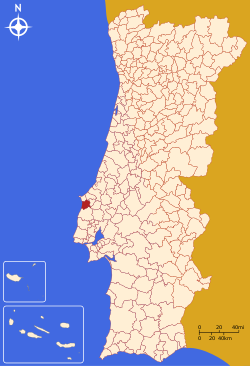Lourinhã
| Lourinhã | |||
|---|---|---|---|
| Municipality | |||
|
|||
 |
|||
| Coordinates: 39°14′N 9°18′W / 39.233°N 9.300°WCoordinates: 39°14′N 9°18′W / 39.233°N 9.300°W | |||
| Country |
|
||
| Region | Centro | ||
| Subregion | Oeste | ||
| Intermunic. comm. | Oeste | ||
| District | Lisbon | ||
| Parishes | 8 | ||
| Government | |||
| • President | João Duarte (PS) | ||
| Area | |||
| • Total | 147.17 km2 (56.82 sq mi) | ||
| Population (2011) | |||
| • Total | 25,735 | ||
| • Density | 170/km2 (450/sq mi) | ||
| Time zone | WET/WEST (UTC+0/+1) | ||
| Website | http://www.cm-lourinha.pt | ||
Lourinhã (Portuguese pronunciation: [loɾiˈɲɐ̃]) is a municipality in the District of Lisbon, in subregion Oeste in Portugal. The population in 2011 was 25,735, in an area of 147.17 km². The seat of the municipality is the town of Lourinhã, with a population of 8,800 inhabitants.
The present Mayor is João Duarte, elected by the Socialist Party.
The name Lourinhã possibly originated in the period of Roman domination, when a villa was located in the area. The origin of the medieval village is linked to Jordan, a French knight who took part in the successful Siege of Lisbon in 1147. King Afonso Henriques granted Jordan the region of Lourinhã as fief and allowed him to grant a foral (letter of feudal rights) to its settlers in 1160. The name Lourinhã may be related to the origin of its feudal lord, since Jordan was from the Loire region in France.
The rights of Lourinhã were confirmed by letters of King Sancho I in 1218 and again by Afonso III in 1258. The parish of Lourinhã became one of the richest of the Lisbon Diocese, as reflected by its main church, a fine example of 14th-century Portuguese Gothic architecture. The Gothic works of the main church were sponsored by Lourenço Vicente, a Lourinhã-born Archbishop of Braga who received the village as a donation of King John I in 1384.
...
Wikipedia


